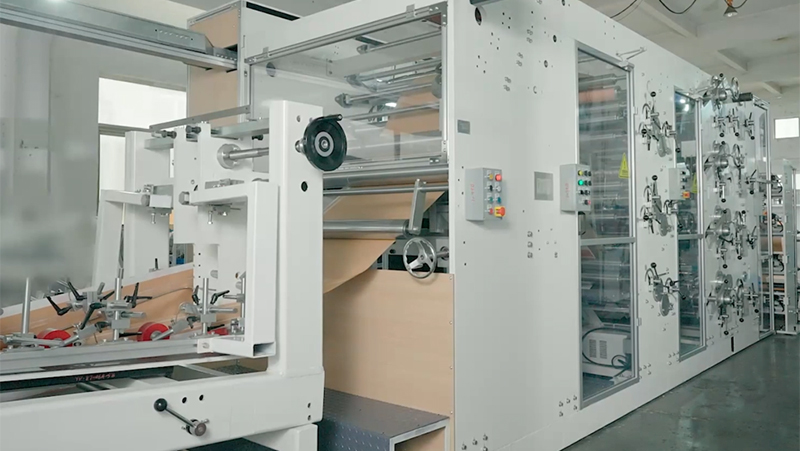Advancements in Paper Bag Manufacturing Technology: Pioneering Sustainable Packaging Solutions
Release time:2025-05-26 Classification:Knowledge
The global shift toward eco-conscious consumerism has propelled significant innovation within the paper bag manufacturing sector. As industries prioritize sustainability, paper bag machines have undergone transformative upgrades to enhance efficiency, reduce waste, and meet evolving market demands. This article explores cutting-edge advancements in paper bag machine technology, emphasizing their role in shaping the future of sustainable packaging.

1. Automation and Precision Engineering
Modern paper bag machines now integrate advanced automation systems, streamlining production while minimizing human intervention. Sensor-driven mechanisms ensure precise alignment of materials, reducing errors in folding, gluing, and cutting. For instance, servo motor technology enables dynamic adjustments during high-speed operations, optimizing output without compromising structural integrity. Such innovations not only boost productivity by up to 40% but also lower energy consumption, aligning with green manufacturing principles.
2. Material Efficiency and Waste Reduction
Next-generation machines prioritize material optimization through AI-powered pattern recognition. By analyzing paper grain orientation and tensile strength, these systems calculate the most efficient cutting layouts, reducing raw material waste by approximately 15–20%. Additionally, closed-loop adhesive application systems now recycle excess glue, further minimizing resource expenditure. These improvements address both economic and environmental concerns, making paper bags a cost-competitive alternative to plastic.
3. Modular Design for Customization
Flexibility has become a cornerstone of contemporary paper bag machinery. Modular configurations allow manufacturers to swiftly adapt to diverse specifications—switching between flat-bottom, SOS (self-opening sacks), or twisted-handle designs within minutes. Enhanced die-cutting modules support intricate shapes and branding elements, catering to premium markets. This adaptability empowers businesses to respond dynamically to client needs while maintaining lean inventories.
4. Sustainable Energy Integration
Innovators are reimagining power systems to reduce carbon footprints. Hybrid machines combining electric and kinetic energy recovery systems (KERS) now reclaim energy during deceleration phases, slashing overall power consumption by 25%. Solar-compatible models are also emerging, particularly in regions with renewable energy incentives. Such advancements position paper bag production as a leader in low-impact manufacturing.
5. Smart Diagnostics and Predictive Maintenance
IoT-enabled sensors embedded in modern machines provide real-time performance analytics. Vibration analysis algorithms detect bearing wear or misalignment weeks before failure, while humidity monitors adjust settings to prevent paper jams. Cloud-based dashboards offer remote troubleshooting, reducing downtime by up to 30%. This predictive approach transforms maintenance from reactive to strategic, ensuring uninterrupted production cycles.
6. Enhanced Safety and Ergonomics
Recent designs prioritize operator safety through intelligent safeguards. Laser-guided zones halt machinery when hands breach operational perimeters, and noise-dampening enclosures reduce workplace decibel levels. Ergonomic interfaces with haptic feedback simplify complex adjustments, lowering training time for new technicians. These human-centric upgrades foster safer, more efficient working environments.
7. Water-Based Coating Systems
To replace traditional plastic laminates, innovators have developed aqueous coating units that apply biodegradable barriers. These coatings provide moisture resistance without hindering recyclability, addressing a longstanding limitation of paper packaging. UV-curing options further accelerate drying times, enabling faster turnaround for specialty orders.
8. Scalability for Small-Batch Production
Countering the "mass production only" stereotype, compact modular machines now enable economical small runs. Quick-change tooling and digital parameter presets allow cost-effective production of 500–5,000 units, democratizing access for boutique brands and local businesses. This scalability supports the growing demand for customized, limited-edition packaging.
9. Blockchain-Enabled Quality Tracking
Pioneering systems now embed QR code printing modules linked to blockchain platforms. Each batch’s data—including material sources, energy usage, and production timestamps—is immutably recorded. Brands leveraging this feature can transparently verify sustainability claims, bolstering consumer trust in an era of greenwashing concerns.
A Catalyst for Circular Economies
The relentless innovation in paper bag machinery transcends mere technical upgrades—it represents a systemic shift toward circular production models. By harmonizing speed, customization, and ecological responsibility, these advancements empower manufacturers to meet stringent sustainability targets while maintaining profitability. As regulatory pressures mount and consumer preferences evolve, investing in next-gen paper bag technology will remain pivotal for businesses aiming to lead in the green packaging revolution. The future lies not just in making paper bags, but in redefining how they’re made.






